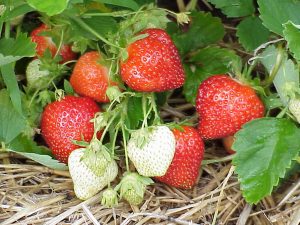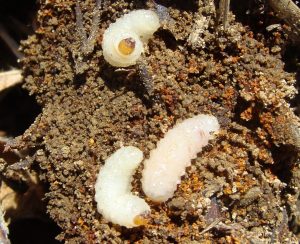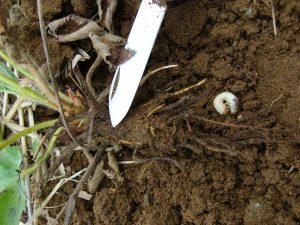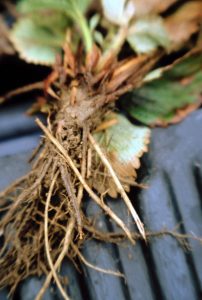Strawberry IPM Newsletter No. 1 – May 18, 2018
 University of Maine Strawberry IPM Newsletter No. 1 May 18, 2018
University of Maine Strawberry IPM Newsletter No. 1 May 18, 2018
Click on photos to enlarge.
2018 STRAWBERRY PEST MANAGEMENT SEASON BEGINS
Twilight Meeting Wednesday, June 6, Pineland Farms, New Gloucester
Situation:
Just like last year, we may see some impact of the dry growing conditions of last summer on the 2018 harvest. Beds with inadequate or no irrigation did not develop optimal plant populations due to poor runner establishment. As a result, many beds look thinner than we would like and may have a somewhat smaller crop. However, winter survival of plants looks very good, except where deer or turkeys pulled off mulch and damaged plants. Winter injury can be diagnosed by cutting into the crowns of the strawberry plants. The internal tissue will show dark brown discoloration. To reduce the impact of winter injury, make sure the plants get plenty of water, and apply nutrients to encourage root growth and flower development, including nitrogen, calcium, and phosphorus. Heavy nitrogen fertilizer applications in the spring are not recommended, but up to 20 pounds of actual N (e.g. 125 lb. calcium nitrate) may improve early spring growth.
2017-2018 New England Small Fruit Management Guides are available from UMaine Cooperative Extension if you didn’t get your copy last year. The guide contains the latest information on management options for small fruit pests as well as cultural information. You can also access the guide on the UMass Extension website.
We began scouting strawberry fields for major insect pests this week, and will be working with volunteer farms in Wells, Limington, Cape Elizabeth, Minot, New Gloucester, Dresden, Monmouth, Wayne, and Farmington. The results of our scouting will be reported through this newsletter and blog on a weekly basis until harvest time. You can also get quick access to this information on the UMaine Pest Management web page. If you would prefer to receive this newsletter via e-mail, please give us a call at 933.2100 or send an e-mail message to: pamela.stpeter@maine.edu.
The best way to manage strawberry pests is to scout your own fields regularly and often. You should begin to scout as soon as flower buds emerge from the crowns and continue to monitor the plantings one or two times per week up until harvest. You should be able to identify the major pests and their damage, and be able to determine if control measures are necessary. To properly scout your fields, you may want a copy of the Strawberry Production Guide for the Northeast, Midwest and Eastern Canada. This contains detailed information on strawberry pest identification and monitoring, and also provides information on all other aspects of strawberry production. It may be purchased for $45.00 per copy from the University of Maine Cooperative Extension Publications Catalog online.
Strawberry bud weevil or “clipper” will soon become active as flower buds begin to emerge. Although we did not find any clipped buds this week, we did see some chewed holes in the petals of primary flowers indicating that clippers are starting to feed. The clipper is a small weevil, which girdles strawberry flower buds, causing them to dry up and fall off the flower stalk. Scout for damage by counting the number of clipped buds in two feet of row length at five different locations in a field. If the average number of clipped buds per two-foot sample exceeds 1.2, or if live clippers are found, control measures are recommended. Damage is usually first noticed at the edges of the field. Border sprays may be effective in keeping this insect from becoming a problem in larger fields. Fields with a history of clipper problems will typically exceed threshold nearly every year. Insecticide options for clipper include Lorsban®, Brigade®, Sevin® and PyGanic®.
Tarnished plant bug adults are active and were found in several strawberry fields this week. These insects will soon be laying eggs in strawberry leaf and flower stems. Once the eggs start to hatch, the nymphs will begin feeding in the flowers. The nymphs are small, active, yellow-green insects. They can appear very quickly in warm weather, so it is important to scout for them regularly. Tarnished plant bugs feed on open strawberry flowers and young fruit, causing the berries to have seedy ends. To scout for the nymphs, tap or shake 30 flower clusters (six clusters in five different locations) over a plate. If four or more of the clusters out of the 30 sampled have any nymphs, control measures should be taken. Be on the alert and scout your fields as soon as open flowers appear! Insecticide options for tarnished plant bug include Assail®, Brigade®, Danitol®, Dibrom®, and PyGanic®.
Cyclamen mites: Plants showing weak growth and yellow, pinkish or blackened, crinkled leaves may be infested with cyclamen mite. These mites are very small, smaller than spider mites, and reside in the crown of the strawberry plant feeding on the developing leaves and flower buds. They are very hard to see, even with magnification. Infested plants have shrunken distorted leaves and flower stalks, and produce few, if any, marketable fruit. The miticide Portal® can be effective, but must be applied in lots of water and a spreader adjuvant to be sure that the material is carried down into the crowns where these mites reside.
- Two-spotted Spider Mites; photo by David Handley.
Two-spotted spider mites can be a problem in the spring, especially for plants under row covers. We have found mites in nearly every field scouted this week, but in relatively low numbers, not yet requiring control measures. However, mites reproduce rapidly when warm weather arrives, so it is important to scout for them regularly. Spider mites mostly feed on the undersides of strawberry leaves, rasping the plant tissue and sucking the sap. Infested leaves will develop yellow flecking and a bronzed appearance. The plants become weakened and stunted. Fields that have had excessive nitrogen fertilizer and/or row covers tend to be most susceptible to mite injury. To scout for mites, collect 60 leaves from various locations in the field and examine the undersides for the presence of mites. Mites are very small – you may need a hand lens to see them. Chemical control options for two-spotted spider mites include Acramite®, Portal®, Nealta® Savey®, Zeal®, Vendex®, Oberon®, Brigade®, Danitol® and JMS Stylet Oil® (oils will cause plant injury if used in combination with captan or within 14 days of an application of sulfur).

Root weevil management
Fields that were infested with root weevils last summer should be inspected for grubs this spring. Infested plants appear weak and stunted, usually in somewhat circular patches in a field. Digging under the plants will reveal small (1/4”-1/2”) crescent-shaped legless grubs. Typically, the grubs begin to pupate when the plants are in bloom. A soil drench of Platinum® (thiamethoxam) insecticide during the spring and/or fall when the grubs are active in the soil can provide control. However, Platinum® has a 50 day pre-harvest interval, so it is too late for applications in most fruiting fields this year. Platinum® may also be used as a pre-plant or planting treatment for root weevils. It is not too late to put on an application of nematodes to control the grubs (optimal timing is about mid-May). Two species of nematodes appear to offer the best control of root weevil grubs. Heterorhabditis bacteriophora (Hb) appears to be the best candidate for control of root weevils when the soil temperature is above 60 degrees, and is available from Green Methods, the Integrated Biocontrol Network, and Koppert Biological Systems.
Nematodes are living organisms and they can be killed if they are misapplied. Order nematodes ahead of time and be ready to apply them through a sprayer or irrigation soon after they arrive. Refrigerate them if you cannot apply right away. Do not apply nematodes using a sprayer with a piston pump. Use clean equipment, removing all screens finer than 50-mesh. Apply nematodes in early morning or evening in a high volume of water to already moist soil, pre-irrigating if needed. Apply another ¼ inch of irrigation after application to wash them onto and into the soil. Researchers and suppliers recommended 250 (if banded in the row) to 500 million per acre, at a cost of $100-$200 per acre depending on volume and source. Nematodes tend to work best in heavily infested fields. Strawberry plants can recover their vigor remarkably well if crown feeding has not occurred and diseases haven’t taken over the roots.
Once the adults become active in July, bifenthrin (Brigade®) will provide some control if used at the highest labeled rates. The best timing for this spray is at night during the peak feeding activity of adults, before they start laying eggs, or about the time harvest ends.

White grubs: Weak growth noted in fields this spring may also be the result of white grubs feeding on the roots of newer plantings. These grubs are the larvae of beetles, including European chafer and Asiatic garden beetle. They differ from the larvae of black vine weevil and strawberry root weevil in that they have legs and a swollen anterior (rear end), and they tend to be larger. Their feeding weakens the plants by reducing the number of roots. The grubs can be found by pulling up weak plants and sifting through the soil that surrounded the roots. Controlling white grubs once they have become established in a field can be difficult. These tend to be more of a problem in new fields that have been planted following a grass rotation crop, because the adults prefer to lay their eggs in sod. Admire Pro® and Platinum® insecticides are labeled for control of white grubs and should be applied within two hours of irrigation or rainfall to be sure the chemical gets into the root zone. Admire Pro® requires a 14 day to harvest interval, while Platinum® requires a 50 day pre-harvest interval.

Diseases: Bloom is a critical time to protect strawberry fruit against gray mold caused by the fungus Botrytis cinerea, especially when conditions have been damp. Two to three sprays of fungicide during bloom are typically required to provide good protection against this disease. If you tank mix insecticides and fungicides, avoid spraying when bees are active. Botrytis cinerea overwinters on old leaves and plant debris. Fruit infections take place almost exclusively through the flowers, so gray mold control efforts must be focused on the bloom period. If the bloom period is dry and/or good fungicide coverage is maintained, incidence of gray mold at harvest should be low.
There are several excellent fungicide choices for control of gray mold in strawberries. Elevate® (fenhexamid) has good to excellent activity against Botrytis. Captevate® is a pre-mix of captan and fenhexamid and has a broader spectrum of activity than Elevate® alone. Switch® (cyprodinil and fludioxonil), Scala® (pyramethanil) and Pristine® (pyraclostrobin and boscalid) are also excellent products for gray mold control. Topsin M® + captan is also a good fungicide combination, but remember that captan is strictly a protectant and can be washed off by rain or irrigation water. Thiram is similarly effective but also susceptible to wash-off.

The fungicides Cabrio® (pyraclostrobin) and Abound® (azoxystrobin) are NOT suitable for gray mold control, but are effective against anthracnose and other fruit rot and leaf spot diseases. All fungicides mentioned above have a 0-day pre-harvest interval, except Topsin M® (1 day) and thiram (3 days). Remember to alternate fungicides with different modes of action for resistance management purposes.
Red stele root rot
Although early spring conditions were not especially conducive to red stele development, you should still be alert for this root rot if any fields appear to be weak, stunted or dying. To diagnose red stele, pull up a few plants that look weak and scrape the roots of these plants to see if the center of the root, known as the stele, is rusty red in color, instead of the normal white. The red color would indicate an infection. Red stele is caused by Phytophthora fragariae, a soil pathogen that infects roots when soils are wet with temperatures around 50°F. The pathogen grows into the roots causing the plants to become weak, stunted and to eventually die. Symptoms are most evident in the spring, and can be mistaken for winter injury. Ridomil Gold®, Alliette® or Phostrol® are fungicides that can be applied in the late fall or early spring for control of red stele. In newly planted beds, RootShield® may be applied as a pre-plant root dip to help prevent infections. Many varieties have some level of resistance to the disease, but the most effective management strategy is to plant only into well-drained soils, and/or plant onto raised beds.
Powdery mildew: This fungus disease may first show up as purple or red blotches on the leaf petioles and flower stems in strawberry fields. Most of us are more familiar with the later symptoms of upward curling of the leaves and white, powdery growth on the undersides of the leaves. We haven’t found symptoms yet, but they can appear rapidly once daily temperatures get warmer. Check your fields for pinkish purple leaf and flower stem lesions as new leaves emerge. Pristine®, Cabrio®, Topsin-M®, captan, Procure®, Torino® and JMS Stylet Oil® are presently registered to control powdery mildew.
Angular leaf spot is a bacterial disease that is characterized by translucent leaf spots that may turn yellow and eventually black. The symptoms tend to start on the lower leaves but may move upwards as bacterial spores are splashed up by rain or irrigation water. Infection of the calyxes may result in a blackening of the berry stems and caps, reducing their marketability. Bacterial angular leaf spot is favored by extended cool, wet weather and nights with temperatures close to freezing. Frequent irrigation for frost protection can greatly encourage the development and spread of the disease, as will extended cool, damp weather. Susceptibility to this disease appears to vary significantly between varieties. The copper-containing material Kocide®, can reduce the spread of this disease. Start spray applications before bloom to prevent multiplication of the bacteria on the leaves before they jump to the berry caps. Application of copper sprays after bloom can result in fruit injury and is not recommended. Hydrogen dioxide (OxiDate®) may also have some activity against angular leaf spot when used on strawberries as part of a gray mold management program.
Other Berries:
Raspberries are showing little winter injury so far, but often winter injury becomes apparent once the floricanes start to flower. Tip dieback often occurs due to winter damage to the vascular tissue within the canes. Flower buds are starting to emerge on early varieties in southern Maine. These are susceptible to damage from strawberry bud weevil or clipper, as discussed above. Look for clipped buds and weevils regularly once the buds are visible.
Highbush blueberries are showing a very impressive bloom in most fields this spring, offering the potential of a very good crop, if conditions for development are right. If fruit set is heavy, be sure to supply adequate irrigation and nutrients during the growing season to support fruit development, reduce stress on the plants and to assure good bud development for next year. Mummy berry spores will soon be active. Expect infection periods to occur over the next few weeks, anytime there is a significant moisture event (rain, mist, fog). Protectant fungicides for mummy berry include Indar®, Orbit®, and Quilt Excel®.
Twilight Meeting Wednesday June 6th, Pineland Farms, 752 Mayall Road, New Gloucester. Justin Gray, Manager of Pineland Farms Produce Division will discuss berry and vegetable production on this intervale site with sandy soils and extensive irrigation engineering. The farm markets both locally through U-pick and a farm market, and supplies large market chains through much of the season, specializing in berries, sweet corn and pumpkins. We will also get an update on the berry pest situation around the state, and have an opportunity to look over the equipment they use and have adapted for their operation. The meeting will run from 5:00 p.m. to 7:00 p.m. More details to follow. Hope to see you in New Gloucester!
Sincerely,
David T. Handley
Vegetable and Small Fruit Specialist
Highmoor Farm, P.O. Box 179, 52 US Route 202, Monmouth, ME 04259, 207.933.2100
UMaine Extension Diagnostic Research Lab, Pest Management Unit, 17 Godfrey Drive, Orono, ME 04473, 1.800.287.0279
Where brand names or company names are used it is for the reader’s information. No endorsement is implied nor is any discrimination intended against other products with similar ingredients. Always consult product labels for rates, application instructions and safety precautions. Users of these products assume all associated risks.
The University of Maine is an equal opportunity/affirmative action institution.

